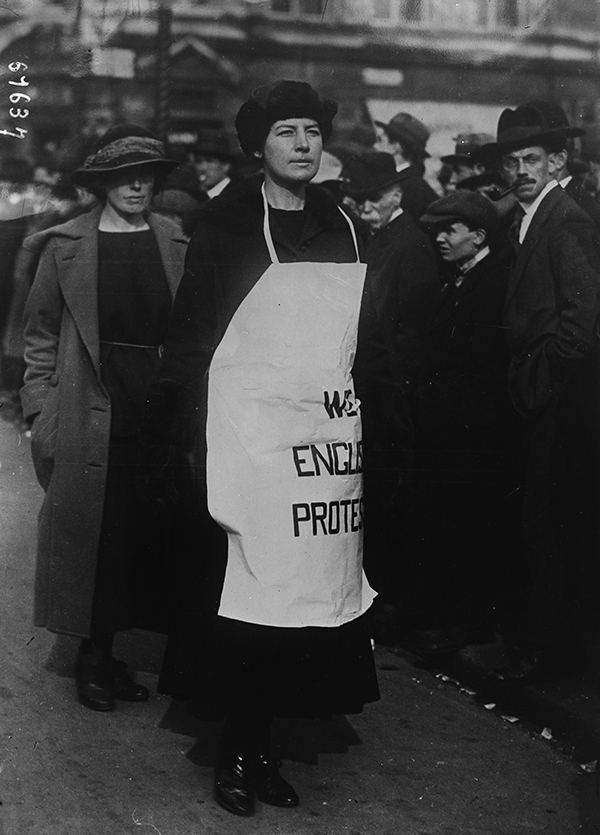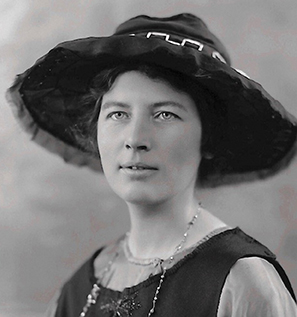‘We English protest’—Margaret Buckmaster’s peace crusade
Published in Features, Issue 4 (July/August 2021), Volume 29By Eugene Dunphy
By late 1920, liberal-minded English men and women had grown weary of hearing daily reports from Ireland about the thuggish behaviour of the Black and Tans and the Auxiliaries (‘Auxies’). ‘Not in our name’, was their response, when reading of the burning of Balbriggan and other acts of violence perpetrated by Crown forces. Following the death on hunger strike of Terence MacSwiney, they were baffled as to why British government officials were still refusing to negotiate a settlement with Sinn Féin and the IRA.
Peace with Ireland Council (PIC)
Former Scottish MP Annan Bryce and his wife Violet (née L’Estrange) wanted to listen to those who were being constantly branded as ‘murderers’ and ‘terrorists’ by the British government, so they took it upon themselves to go on a fact-finding mission to Ireland. While staying at Eccles Hotel, Glengariff, Co. Cork, they soon became aware of the insidious nature of the Anglo-Irish war, when a lorryload of Tans from Bantry drew up outside the hotel, entered the building and handed Annan Bryce an unsigned, undated letter, the contents of which promised immediate reprisals if any ‘loyalists’ or members of the Crown forces were attacked. On 29 October 1920, while on her way to present a talk on Irish affairs at Tonypandy, Wales, Violet Bryce was arrested and body-searched at Holyhead, just as she disembarked from the Kingstown mail-boat. Detained for four hours, she was outraged by her treatment at the hands of the British military, and infuriated that a warrant was not produced though she had repeatedly asked to see one. When her case was mentioned in the Houses of Commons and Lords, she was issued with ‘an apology’.
Consequently, Annan and Violet Bryce became key members of the Peace with Ireland Council (PIC), which was founded on 9 November 1920 by Lord Henry Cavendish Bentinck, following a meeting at the House of Commons. Historian Basil Williams was elected treasurer, and 27-year-old Margaret Buckmaster, an ardent suffragette, socialist and eldest daughter of Lord Buckmaster, acted as honorary secretary. Within days, the PIC set up headquarters at 30 Queen Anne’s Chambers, Tothill Street, Westminster. Their remit was to ‘appeal to public opinion to vindicate the fundamental British principles of law and order; to protest against the lawless policy of reprisals countenanced by the Government, and to assist in providing relief in cases of distress arising from whatever cause in the struggle in Ireland’.
A PIC branch consisting of academics and students was soon established at Cambridge University. While delivering an address to its members, Lord Buckmaster made it clear that ‘the administration of law in Ireland is only supported by terror and as the terror grows, hatred of the law grows at the same pace’. On 4 December, the PIC staged a rally at the Albert Hall. On their way into the venue, audience members were given the opportunity of purchasing copies of James Connolly’s The watchword of Labour, as well as Connolly’s Labour, nationality and religion (1,000 copies of the latter publication had been seized on 15 November 1920, when the Black and Tans raided the James Connolly Labour College at 42 North Great George’s Street, Dublin). Chaired by Lord Bentinck, speakers at the Albert Hall event included Lord Buckmaster and former prime minister Herbert Asquith. Things were going swimmingly until Asquith said that the organisers of the 1916 Rising were found guilty ‘by trial’. ‘No, they were murdered,’ a voice cried out. ‘They were not tried. They were murdered!’ At another meeting at Oxted, on 9 December, Annan Bryce was shouted down by a large contingent of comrades of the Great War when stating that the British government had adopted a ‘counter-policy of murder’ in Ireland.
‘Heartily ashamed’
Soon after, Bentinck sent a letter to Prime Minister Lloyd George, urging him to withdraw the Tans and Auxies and to put an end to martial law in Ireland. At a subsequent rally at Montfort Hall, Leicester, Bentinck delivered an address to a large audience, many of whom were first- or second-generation Irish. Not only was he ‘heartily ashamed’ of the British government, but he firmly believed that Lloyd George was ‘slavishly following the example of every petty tyrant in history’ by not talking to Irish representatives. When Canon William Elliot referred to the suffering endured by Crown forces, a voice from the crowd piped up, ‘They’ve no right to be there’. ‘That is another point,’ said Elliot. ‘That is the point’, came the retort. The next speaker, Violet Bryce, received a rapturous round of applause when she accused the government of trying to cover up their ‘deplorable behaviour’ in Ireland. If a solution was going to be found, she said, the government needed to talk to the IRA.
At a PIC meeting at Maida Vale, war correspondent Henry Nevinson told the assembled that he had seen some extreme violations of human rights in his time, but they paled into insignificance when compared to the brutality he had witnessed being meted out by the Tans and Auxies in the last few months. At a venue in Golders Green, in February 1921, audible sighs of disbelief could be heard from the crowd as Lord Buckmaster read out selections from Weekly Summary, a disturbing government document that acted as a sort of tit-for-tat guide for Tans and Auxies operating in Munster:
‘That in the event of one member of His Majesty’s forces being killed, two members of the Sinn Féin Council in Cork would be killed, and were they not available three sympathisers would be killed … That in the event of one member of the forces being wounded or an attempt made, one member of Sinn Féin would be killed, or if one member was not available, two sympathisers would be killed.’

Above: ‘WE ENGLISH PROTEST’— Margaret Buckmaster at the demonstration in Trafalgar Square organised by the Peace with Ireland Council and the Women’s Freedom League on 2 July 1921. (Bibliothèque nationale de France)
Margaret Buckmaster

Above: Margaret Pollock (née Buckmaster), suffragette and socialist, died of pneumonia, aged 36, in 1929. A scholarship—‘to assist each year some poor student of ability who is in financial need’—still bears her name in Somerville College, Oxford. (NPG UK)
Almost on a daily basis, the PIC was attracting a host of new members, including Lady Asquith, Lady Sykes, Lady Aberdeen and Lady Bonham-Carter. The literati also lent their support, in the form of W.B. Yeats, George Bernard Shaw, Hilaire Belloc, St John Irvine and H.G. Wells. By the end of April, the PIC had held 100 meetings and had twenty branches in England. Probably one of the most outspoken and passionate members of the Council was Margaret Buckmaster. Having recently returned from a trip to Ireland, on 10 May she presented a lecture at Victoria Hall, Henley, in the course of which she said that Protestant England had a shameful history when it came to Ireland, and that it should apologise for having inflicted the anti-Catholic Penal Laws on the Irish people; she also called for ‘complete and unfettered self-determination for Ireland’. Reading aloud the tit-for-tat extracts from the Weekly Summary, she said that no one should be surprised at the atrocious behaviour of the Tans and Auxies; after all, they had been ‘shut up in barracks, given as much drink as they wanted, and then let loose over the countryside’, all at the behest of London and their servants at Dublin Castle.
The speech was cheered by the vast majority of her listeners, but it failed to impress Revd Arthur Sinker, who stood at the back of the hall, arms folded and dismayed. Returning to St George’s vicarage, he penned a letter of complaint for the attention of the editor of the Staffordshire Sentinel:
‘Nothing was left unsaid in the way of invective against those men, the police and soldiers, who face death day and night, with a courage the world has never seen equalled’.
Accusing those who took part in the Easter Rising of being responsible for ‘the massacre of Sherwood Foresters’, he asked: ‘Why was no mention made of the 109 policemen shot in the back before there had been a single reprisal?’ Alluding to the assassination of fourteen British intelligence officers on 21 November (Bloody Sunday), which was sanctioned by Michael Collins and carried out by the ‘Twelve Apostles’, he described the attacks as ‘revolting brutality’. ‘Peace’, he added, can only be discussed with people ‘whose hands are clean of blood’. Having read the article at her home in Porchester Terrace, Hyde Park, Margaret drafted her response, which was published on 19 May:
‘Mr Sinker speaks as though the rebels who took part in the Easter Rebellion—a small number compared to the Irishmen fighting in France—were men of singularly brutal character. This is not the experience of those better able to judge … Does he know that in 1918 there were 260 raids on private houses; 1,107 arrests for political offences; 91 deportations without charge or trial; 80 meetings broken up with bayonets and batons; 5 civilians killed by Crown forces, and that during the whole year, no policeman lost his life? … Surely, it is only logical that those who are responsible for bloodshed should be responsible for ending it: in other words, a peace must be negotiated between the British Government and the Irish people.’
Trafalgar Square demonstration
Just days later, the PIC published a full account of the Black and Tan murder in Cork of Fr Seamus O’Callaghan, as told by an eyewitness, Alderman Liam de Róiste. It made uncomfortable reading for British officials, who now showed signs of yielding to public pressure and negotiating with Irish officials. On 2 July 1921, the PIC joined forces with the Women’s Freedom League to stage a huge peace rally in London. Crowds met at 2pm, at the city side of Charing Cross Bridge, and made their way to Trafalgar Square to hear twenty speakers denounce the British government’s intransigence. A French journalist in attendance photographed Margaret Buckmaster walking past a line of perplexed-looking men; she is dressed in mourning black, and wearing a long white apron bearing the words, ‘WE ENGLISH PROTEST’.
Following the signing of the Anglo-Irish Treaty on 6 December 1921, Buckmaster stepped back from Irish affairs, and on 22 December she married 56-year-old Dighton Pollock, junior counsel to the British Treasury. While looking after two children, Margaret still found time to campaign for women’s rights through the Women’s International League. Becoming an active member of the North Kensington Labour Party, she was instrumental in setting up the North Kensington Women’s Welfare Centre; she also wrote These common things, which called for equal pay for women.
Family tragedies
But tragedy soon visited the Pollock household. After a short illness, her husband died in March 1927. While out campaigning for the Labour Party in the summer of 1929, Margaret herself contracted pneumonia and died a week later, on 4 June. Her book The women of today, which she had just finished writing, was published posthumously by Routledge. Shortly before his death in December 1934, Lord Buckmaster drafted his will, part of which bequeathed £200 to the Labour Party and £3,000 to Somerville College, Oxford, towards a scholarship fund in memory of his peace-loving daughter Margaret.
Eugene Dunphy is a music teacher in Belfast.
FURTHER READING
D.G. Boyce, Englishmen and Irish troubles: British public opinion and the making of Irish policy, 1918–22 (London, 1994).
M. Moulton, Ireland and the Irish in interwar England (Cambridge, 2014).
















